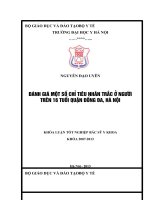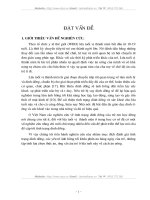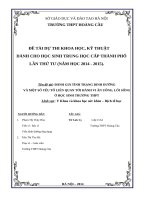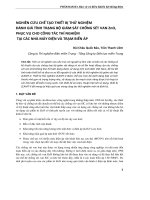Bài giảng Dinh dưỡng cho các lớp Sau đại học 2014 - Bài 4: Đánh giá tình trạng dinh dưỡng
Bạn đang xem bản rút gọn của tài liệu. Xem và tải ngay bản đầy đủ của tài liệu tại đây (529.81 KB, 47 trang )
Nutritional status
Assessment
Dr K N Prasad
Community medicine
Terminology you have to know
Nutrition:
Process by which living organism receives material and uses
them to promote it’s vital activities
Nutrient:
Any substance which is digested and absorbed to promote
body function
Diet:
Selection of food which is normally eaten by person or
population
Food:
Substance when eaten , digested, absorbed provide at least
one nutrient
Balanced diet :
Diet that provide adequate amount of all nutrients
Malnutrition:
Caused by incorrect amount of nutrient intake
Nutritional status:
Health status that produced by balanced
between requirements and intake
Nutritional assessment:
Measurement of nutritional status by
anthropometrics , biochemical data, dietary
history
Nutritional assessment
The nutritional status of an individual is
often the result of many interrelated
factors.
It is influenced by food intake, quantity &
quality, & physical health.
The spectrum of nutritional status spread
from obesity to severe malnutrition
The purpose of nutritional
assessment
Identify individuals or population groups at
risk of becoming malnourished
To obtain precise information about the
prevalence and geographic distribution of
nutritional problems of a community
To develop health care programs that meet the
community needs
To measure the effectiveness of the nutritional
programs & intervention once initiated
Methods
Direct and Indirect.
Direct methods deal with the
individual and measure objective
criteria.
Indirect methods use community
health indices that reflects
nutritional influences.
Direct Methods
These are ABCD
Anthropometric methods
Biochemical, laboratory methods
Clinical methods
Dietary evaluation methods
Indirect Methods
These include three categories:
Economic factors e.g. per capita income,
population density & social habits
Vital health statistics particularly infant &
under 5 mortality & fertility index
Ecological variables including crop
production
CLINICAL ASSESSMENT
It is an essential features of all nutritional
surveys
It is the simplest & most practical method of
ascertaining the nutritional status of a
group of individuals
It utilizes a number of physical signs,
(specific & non specific),
associated with malnutrition
deficiency of vitamins & micronutrients.
CLINICAL ASSESSMENT
Good nutritional history should be
obtained
General clinical examination, with
special attention to organs like hair,
angles of the mouth, gums, nails, skin,
eyes, tongue, muscles, bones, & thyroid
gland.
Detection of relevant signs helps in
establishing the nutritional diagnosis
CLINICAL ASSESSMENT
ADVANTAGES
Fast & Easy to perform
Inexpensive
Noninvasive
LIMITATIONS
Did not detect early cases
Clinical signs of nutritional deficiency
HAIR
Spare & thin
Protein, zinc, biotin
deficiency
Easy to pull out
Protein deficiency
Corkscrew
Coiled hair
Vit C & Vit A
deficiency
Clinical signs of nutritional deficiency
MOUTH
Glossitis
Bleeding & spongy gums
Riboflavin, niacin, folic acid,
B12 , pr.
Vit. C,A, K, folic acid & niacin
Angular stomatitis, cheilosis B 2,6,& niacin
& fissured tongue
leukoplakia
Vit.A,B12, B-complex, folic acid
& niacin
Sore mouth & tongue
Vit B12,6,c, niacin ,folic acid &
iron
Clinical signs of nutritional deficiency
EYES
Night blindness,
exophthalmia
Vitamin A deficiency
Photophobiablurring,
conjunctival inflammation
Vit B2 & vit A
deficiencies
Clinical signs of nutritional deficiency
NAILS
Spooning
Iron deficiency
Transverse lines
Protein deficiency
Clinical signs of nutritional deficiency
SKIN
Pallor
Folic acid, iron, B12
Follicular hyperkeratosis Vitamin B & Vitamin C
Flaking dermatitis
Pigmentation,
desquamation
Bruising, purpura
PEM, Vit B2, Vitamin A,
Zinc & Niacin
Niacin & PEM
Vit K ,Vit C & folic acid
Clinical signs of nutritional deficiency
Thyroid gland
in mountainous areas
and far from sea
places Goiter is a
reliable sign of iodine
deficiency.
Clinical signs of nutritional deficiency
Joins & bones
Help detect signs of
vitamin D deficiency
(Rickets) & vitamin C
deficiency (Scurvy)
Anthropometric Methods
Anthropometry is the measurement of body
height, weight & proportions.
It is an essential component of clinical
examination of infants, children & pregnant
women.
It is used to evaluate both under & over nutrition.
The measured values reflects the current
nutritional status
Don’t differentiate between acute & chronic
changes .
Anthropometrics
Height
Weight
Skin fold thickness (triceps, biceps, below
scapula, above iliac, and upper thigh)
Circumference (head, mid upper arm,
waist, calf, and hip)
Physical growth
Weight for age
Malnutrition
(Gomez)
Height for age
Stunting (waterlow)
Weight for height
Wasting
BMI
Obesity
Weight for age
Malnutrition (Gomez)
W/A= W/W(N) x 100
90-110 = Normal
75-89 = 1st, Mild
60-74 = 2nd
, Moderate
<60 = 3rd, Severe
Height for age
Stunting
H/A=H/H(N) x 100
< -2 SD = Stunted, Wasted
> 95 = Normal
87.5-95= Mild
80-87.5= Moderate
< 80 = Severe
Weight for height
Wasting
W/H= W/W(at same H) x 100
< -2 SD = Stunted, Wasted
> 90 = Normal
80-90 = Mild
70-80 = Moderate
< 70 = Severe
Other Measurements
Mid-arm
Skin
circumference
fold thickness
Head
circumference
Head/chest
ratio
Hip/waist ratio









